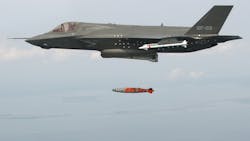F-35A achieves first in-flight missile launch
EDWARDS AIR FORCE BASE, Calif., 10 June 2013. An F-35A conventional takeoff and landing (CTOL) aircraft completed the first in-flight missile launch of an AIM-120 C5 AAVI (AMRAAM Air Vehicle Instrumented).
The aircraft, known as AF-1, launched the missile over the Point Mugu Sea Test Range from the internal weapons bay. It is the first launch where the F-35 and AIM-120 demonstrated a launch-to-eject communications sequence and fired the rocket motor after launch, which paves the way for targeted launches later this year in support of Block 2B fleet release capability.
The Air Force F-35A variant has recently seen significant development in training and operations, to include: the beginning of pilot training at Eglin Air Force Base, the delivery of the first operational test aircraft to Edwards and Nellis Air Force Bases, the first operational pilot aerial refueling, and the completion of high angle of attack testing.
"It's a testament to the entire military-industry test team. They've worked thousands and thousands of hours to get to this point- to where we are today," explains U.S. Air Force Lt. Col. George "Boxer" Schwartz, who in addition to his role as a test pilot serves as the F-35 Integrated Test Force (ITF) Director at Edwards. "It's fantastic to see that it's all paid off. We're rolling into a lot of additional weapons work in the coming months to put that expanded capability on the aircraft."
The F-35A 5th Generation fighter is designed to carry a payload of up to 18,000 pounds using 10 weapon stations. The F-35A features four internal weapon stations located in two weapon bays to maximize stealth capability. The CTOL aircraft can also utilize an additional three external weapon stations per wing if required.
The U.S. Air Force has established an F-35A initial operating capability (IOC) target date of December 2016. By this date, the Air Force will have fielded an operational squadron with 12 or more aircraft with airmen trained and equipped to conduct basic close air support, interdiction, and limited suppression and destruction of enemy air defense operations in a contested environment.
Moving into the active phase of weapons test is another large step toward delivering Block 2B software capability that will enable initial combat deployment.
"We've spent years working on the design of the aircraft, and many months ensuring that weapons could be contained within the aircraft and dropped as designed. This event is the result of tremendous effort and collaboration in the F-35 enterprise, and marks a turning point in F-35 capabilities; the AIM-120 launch is one small, but critical increment toward proving combat capability," says Charlie Wagner, F-35 Weapons Director.



